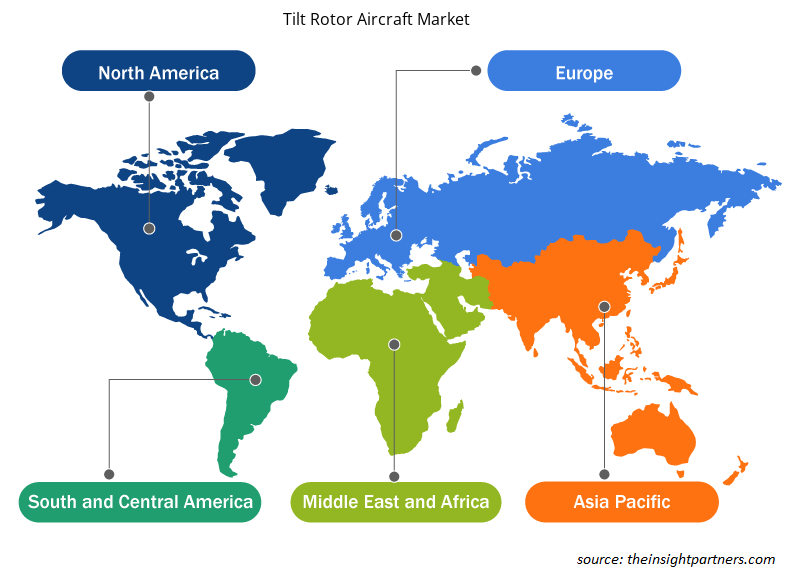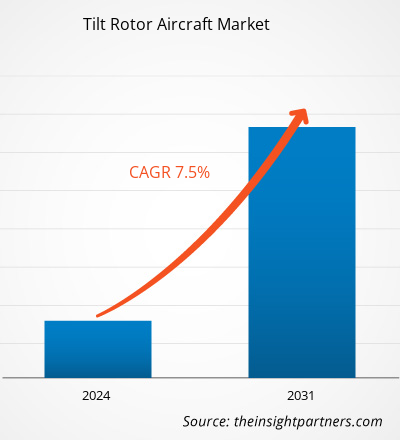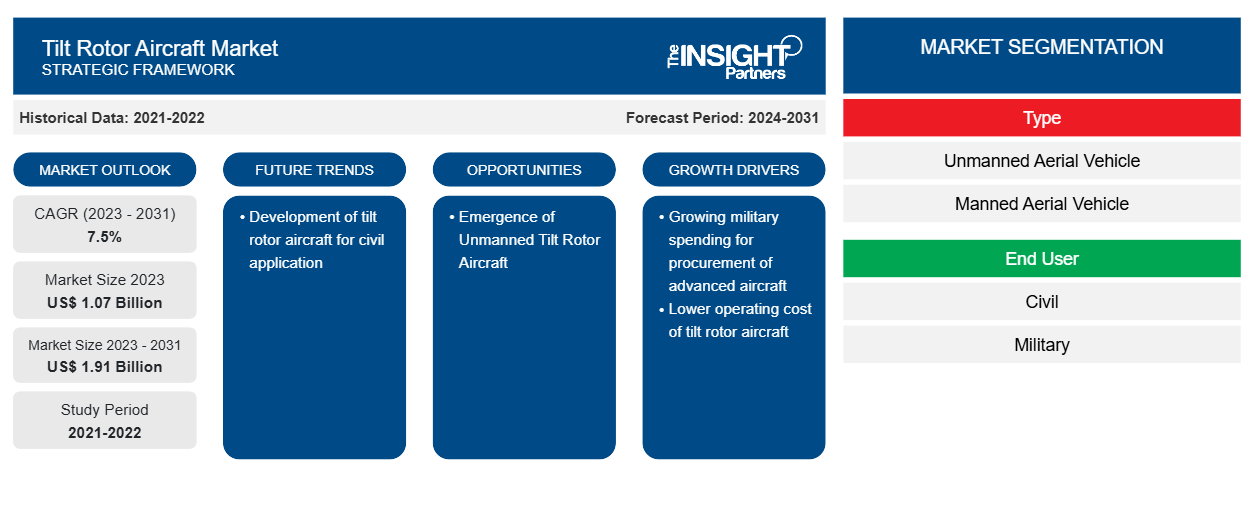Se prevé que el tamaño del mercado de aeronaves de rotor basculante alcance los 1.910 millones de dólares en 2031, frente a los 1.070 millones de dólares en 2023. Se espera que el mercado registre una CAGR del 7,5 % durante el período 2023-2031. Es probable que el desarrollo de aeronaves de rotor basculante para aplicaciones civiles siga siendo una tendencia clave en el mercado.
Análisis del mercado de aeronaves de rotor basculante
Los actores del mercado de aeronaves de rotor basculante están experimentando un importante crecimiento comercial año tras año. Esto se atribuye principalmente al aumento en el número de usuarios finales. El aumento en la adquisición de aeronaves de rotor basculante para aplicaciones militares y civiles está promoviendo gradualmente el poder de negociación de los proveedores. En la actualidad, el poder de negociación de los proveedores de aeronaves de rotor basculante es moderado, sin embargo, se espera que caiga a niveles bajos, ya que los usuarios finales están aumentando y los modelos se construyen con especificaciones similares. El aumento en el número de usuarios finales se relaciona principalmente con el aumento en el desarrollo de modelos de aeronaves de rotor basculante no tripuladas para aplicaciones civiles y militares.
Descripción general del mercado de aeronaves con rotor basculante
Los vehículos aéreos tripulados y los vehículos aéreos no tripulados son los dos tipos de aeronaves de rotor basculante que se ofrecen en el mercado. El número de fabricantes de aeronaves de rotor basculante tripuladas es relativamente bajo. En la actualidad, los modelos de aeronaves de rotor basculante tripuladas están disponibles en las fuerzas de defensa de los EE. UU. y la fuerza de defensa japonesa. El costo de las aeronaves de rotor basculante tripuladas es uno de los principales factores de la menor demanda. Sin embargo, con la comercialización de la aeronave de rotor basculante AW609 de Leonardo, que es aproximadamente US$ 40 millones más barata que la V-22 Osprey, los compradores se animarían a adquirir aeronaves de rotor basculante tripuladas. Este factor se analiza para comprender y representar el poder de negociación de los compradores en los próximos años. Además, los proveedores que operan en el mercado de aeronaves de rotor basculante también se centran principalmente en el desarrollo de productos nuevos e innovadores para seguir siendo competitivos en el mercado.
Personalice este informe según sus necesidades
Obtendrá personalización en cualquier informe, sin cargo, incluidas partes de este informe o análisis a nivel de país, paquete de datos de Excel, así como también grandes ofertas y descuentos para empresas emergentes y universidades.
- Obtenga las principales tendencias clave del mercado de este informe.Esta muestra GRATUITA incluirá análisis de datos, desde tendencias del mercado hasta estimaciones y pronósticos.
Factores impulsores y oportunidades del mercado de aeronaves de rotor basculante
Creciente gasto militar para la adquisición de aeronaves avanzadas
Como las tensiones globales han persistido durante los últimos años, varias naciones afectadas planean y toman medidas para mejorar y recapitalizar el estado de la defensa. Las amenazas evolucionan continuamente, es decir, desde la fuerza terrestre convencional hasta la guerra híbrida. Para abordar las amenazas a la seguridad y hacer frente al terrorismo, los gobiernos de varias naciones ya han comenzado a aumentar sus presupuestos de defensa. Según el Instituto Internacional de Investigación para la Paz de Estocolmo (SIPRI), el gasto militar mundial aumentó a 2.443 billones de dólares estadounidenses en 2023, lo que representa un aumento del 13,7% con respecto a 2022.
Las crecientes tensiones geopolíticas y las guerras entre algunos países de diferentes regiones están impulsando grandes inversiones en el sector de defensa. Una parte importante de la inversión se destina a la adquisición de aeronaves militares avanzadas y aeronaves de rotor basculante. Por ejemplo, en mayo de 2023, Boeing recibió un contrato por valor de 482,3 millones de dólares para la producción y entrega de cuatro aeronaves CMV-22B (Lote 27) para las fuerzas navales de los EE. UU. Por lo tanto, se prevé que la creciente adquisición de aeronaves de rotor basculante para aplicaciones militares impulse el crecimiento del mercado durante el período de pronóstico.
Aparición de aeronaves no tripuladas con rotor basculante
El rápido cambio en la guerra moderna ha estado instando a los gobiernos a asignar mayores fondos a las respectivas fuerzas armadas. La mayor asignación del presupuesto militar permite a las fuerzas militares involucrarse en el desarrollo y adquisición de flotas de guerra avanzadas, incluidos los UAV. El UAV se usa ampliamente para recopilar inteligencia, vigilancia, reconocimiento, adquisición de objetivos, gestión de daños en batalla, entrega, transporte, operaciones de combate y otras aplicaciones. Los ministerios de todo el mundo están invirtiendo cantidades sustanciales con la intención de modernizar las fuerzas armadas. En la actualidad, la modernización de la flota es una de las prácticas más observadas seguidas por la industria aeroespacial y de defensa. Empresas como Textron Inc., China Aerospace Science and Technology Corp. y BNA - Nurol BAE Systems Air Systems Inc. están ofreciendo vehículos aéreos no tripulados (UAV). A medida que el futuro de la guerra aérea está cambiando gradualmente de vehículos aéreos tripulados a vehículos aéreos no tripulados, se proyecta que los actores del mercado de aeronaves de rotor basculante serán testigos de importantes oportunidades de crecimiento durante el período de pronóstico.
Informe de mercado de aeronaves con rotor basculante Análisis de segmentación
Los segmentos clave que contribuyeron a la derivación del análisis del mercado de aeronaves de rotor basculante son el tipo y el usuario final.
- Según el tipo, el mercado de aeronaves de rotor basculante se segmenta en vehículos aéreos no tripulados y vehículos aéreos tripulados. El segmento de vehículos aéreos tripulados tuvo una mayor participación de mercado en 2023.
- Según el usuario final, el mercado de aeronaves de rotor basculante se segmenta en civil y militar. El segmento militar tuvo una mayor participación de mercado en 2023.
Análisis de la cuota de mercado de las aeronaves de rotor basculante por geografía
El alcance geográfico del informe del mercado de aeronaves de rotor basculante se divide principalmente en cuatro regiones: América del Norte, Europa, Asia Pacífico y resto del mundo.
En 2023, América del Norte ha dominado el mercado, seguida de las regiones de Asia Pacífico y Europa. Además, es probable que América del Norte también sea testigo de la CAGR más alta en los próximos años. Estados Unidos representó la mayor participación de mercado en el mercado de aviones de rotor basculante de América del Norte. Estados Unidos es el principal inversor en defensa del mundo y tiene la flota de aviones militares más grande del mundo. El gobierno estadounidense también es conocido por apoyar la investigación y el desarrollo de sistemas avanzados de armas y aviones. Actualmente, el país tiene la flota más grande de aviones de rotor basculante, el V-22 Osprey, que utilizan la Fuerza Aérea, la Armada y el Cuerpo de Marines de Estados Unidos. Se espera que el V-22 Osprey continúe dominando el mercado de aviones de rotor basculante durante el período de pronóstico. Además, el país es conocido por adquirir una gran cantidad de vehículos aéreos no tripulados avanzados.
Perspectivas regionales del mercado de aeronaves de rotor basculante
Los analistas de Insight Partners explicaron en detalle las tendencias y los factores regionales que influyen en el mercado de aeronaves de rotor basculante durante el período de pronóstico. Esta sección también analiza los segmentos y la geografía del mercado de aeronaves de rotor basculante en América del Norte, Europa, Asia Pacífico, Oriente Medio y África, y América del Sur y Central.

- Obtenga datos regionales específicos para el mercado de aeronaves de rotor basculante
Alcance del informe de mercado de aeronaves con rotor basculante
| Atributo del informe | Detalles |
|---|---|
| Tamaño del mercado en 2023 | US$ 1.070 millones |
| Tamaño del mercado en 2031 | 1.910 millones de dólares estadounidenses |
| CAGR global (2023 - 2031) | 7,5% |
| Datos históricos | 2021-2022 |
| Período de pronóstico | 2024-2031 |
| Segmentos cubiertos | Por tipo
|
| Regiones y países cubiertos | América del norte
|
| Líderes del mercado y perfiles de empresas clave |
|
Densidad de actores del mercado de aeronaves de rotor basculante: comprensión de su impacto en la dinámica empresarial
El mercado de aeronaves de rotor basculante está creciendo rápidamente, impulsado por la creciente demanda de los usuarios finales debido a factores como la evolución de las preferencias de los consumidores, los avances tecnológicos y una mayor conciencia de los beneficios del producto. A medida que aumenta la demanda, las empresas amplían sus ofertas, innovan para satisfacer las necesidades de los consumidores y aprovechan las tendencias emergentes, lo que impulsa aún más el crecimiento del mercado.
La densidad de actores del mercado se refiere a la distribución de las empresas o firmas que operan dentro de un mercado o industria en particular. Indica cuántos competidores (actores del mercado) están presentes en un espacio de mercado determinado en relación con su tamaño o valor total de mercado.
Las principales empresas que operan en el mercado de aeronaves de rotor basculante son:
- BAE Systems Plc
- Bell Textron Inc
- Boeing
- Industrias Aeroespaciales de Israel Ltd.
- Leonardo SpA
- Corporación Lockheed Martin
Descargo de responsabilidad : Las empresas enumeradas anteriormente no están clasificadas en ningún orden particular.

- Obtenga una descripción general de los principales actores clave del mercado de aeronaves de rotor basculante
Noticias y desarrollos recientes del mercado de aeronaves de rotor basculante
El mercado de aeronaves de rotor basculante se evalúa mediante la recopilación de datos cualitativos y cuantitativos a partir de una investigación primaria y secundaria, que incluye publicaciones corporativas importantes, datos de asociaciones y bases de datos. A continuación, se enumeran algunos de los avances en el mercado de aeronaves de rotor basculante:
- Textron Inc (NYSE: TXT) anunció hoy que Bell Textron Inc., una empresa de Textron, ha obtenido el contrato de desarrollo para el programa Future Long-Range Assault Aircraft (FLRAA) del Ejército de los EE. UU. La adjudicación se basa en el rotor basculante V-280 Valor de Bell que se desarrolló y probó como parte del programa Joint Multi-Role Technology Demonstrator (JMR TD) que comenzó en 2013. El V-280 progresó a través del diseño, la fabricación y más de tres años de rigurosas pruebas de vuelo que proporcionaron datos extensos que validaron las ventajas técnicas y operativas de la aeronave para la misión de asalto de largo alcance. (Fuente: Textron Inc, comunicado de prensa, febrero de 2022)
- La empresa rusa ZALA Aero presenta drones de rotor basculante con propulsión híbrida. El ZALA VTOL de rotor basculante combina las mejores cualidades de un dron tipo avión y un rotor basculante, y también tiene la capacidad de cambiar la configuración según la tarea que se esté realizando (Fuente: ZALA Aero, comunicado de prensa, abril de 2021)
Informe sobre el mercado de aeronaves de rotor basculante: cobertura y resultados
El informe “Tamaño y pronóstico del mercado de aeronaves de rotor basculante (2021-2031)” proporciona un análisis detallado del mercado que cubre las siguientes áreas:
- Tamaño del mercado de aeronaves de rotor basculante y pronóstico a nivel mundial, regional y nacional para todos los segmentos clave del mercado cubiertos bajo el alcance
- Tendencias del mercado de aeronaves de rotor basculante, así como dinámica del mercado, como impulsores, restricciones y oportunidades clave
- Análisis detallado de las cinco fuerzas de Porter
- Análisis del mercado de aeronaves de rotor basculante que abarca las tendencias clave del mercado, el marco global y regional, los principales actores, las regulaciones y los desarrollos recientes del mercado
- Análisis del panorama de la industria y de la competencia que abarca la concentración del mercado, el análisis de mapas de calor, los actores destacados y los desarrollos recientes del mercado de aeronaves de rotor basculante
- Perfiles detallados de empresas
- Análisis histórico (2 años), año base, pronóstico (7 años) con CAGR
- Análisis PEST y FODA
- Tamaño del mercado, valor/volumen: global, regional y nacional
- Industria y panorama competitivo
- Conjunto de datos de Excel
Informes recientes
Testimonios
Razón para comprar
- Toma de decisiones informada
- Comprensión de la dinámica del mercado
- Análisis competitivo
- Información sobre clientes
- Pronósticos del mercado
- Mitigación de riesgos
- Planificación estratégica
- Justificación de la inversión
- Identificación de mercados emergentes
- Mejora de las estrategias de marketing
- Impulso de la eficiencia operativa
- Alineación con las tendencias regulatorias





















 Obtenga una muestra gratuita para - Mercado de aeronaves de rotor basculante
Obtenga una muestra gratuita para - Mercado de aeronaves de rotor basculante